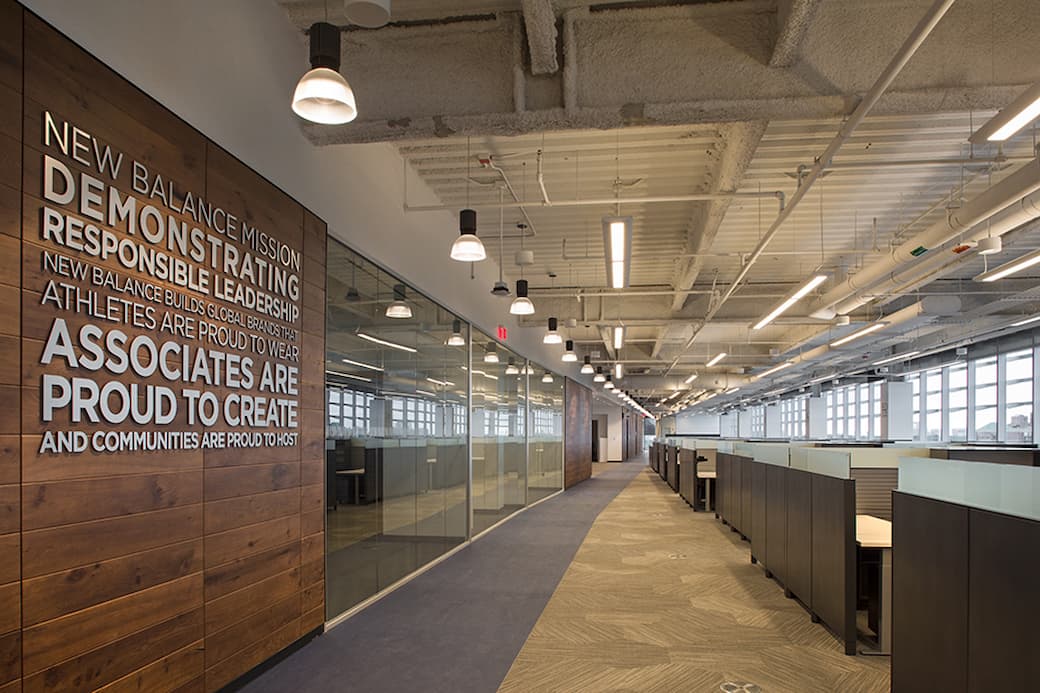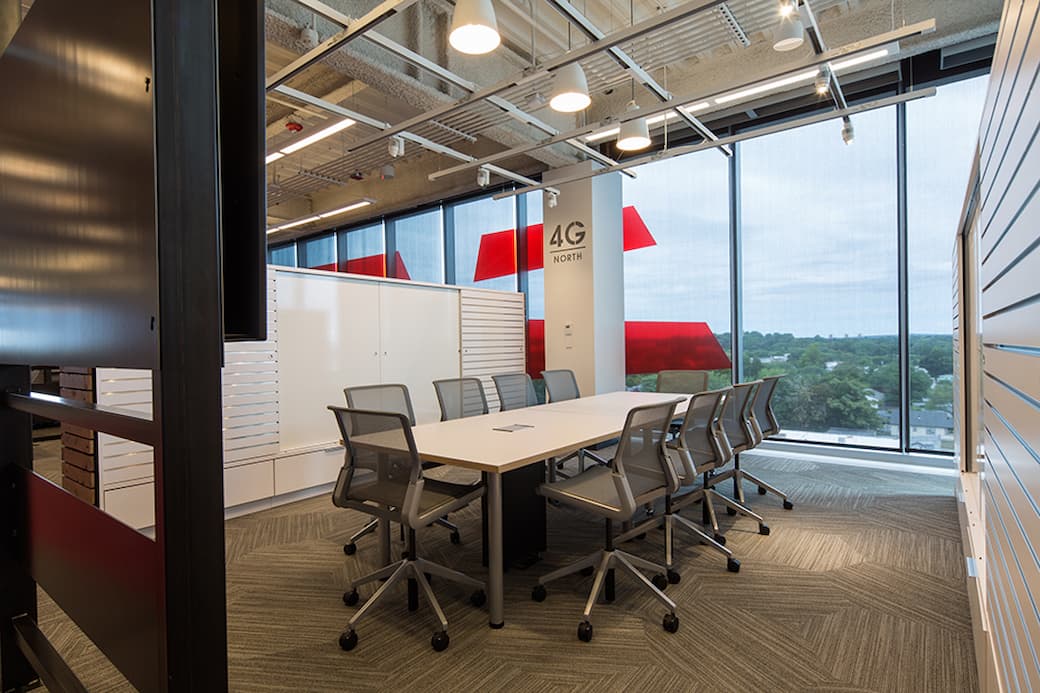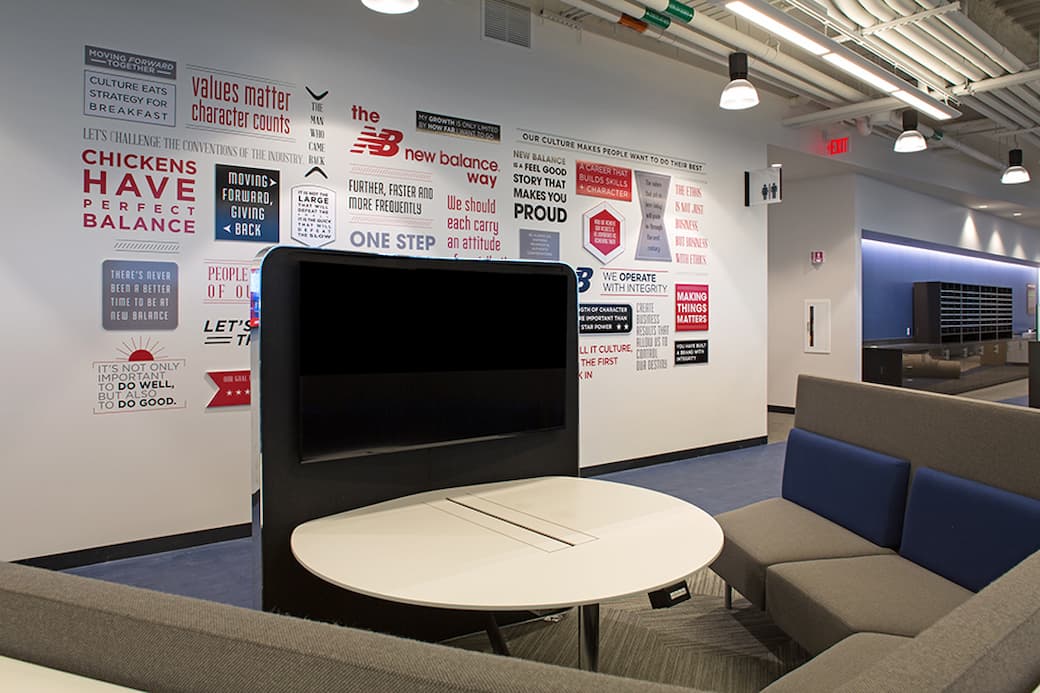Sound Masking Benefits
Green Office Design, LEED Projects, and Sound Masking Technology Play Very Well Together
Completed in early fall 2015, the 250,000-square-foot New Balance World Headquarters in Boston was America's first LEED V2009 Platinum Core & Shell certified project to earn all points in indoor environmental quality—and only the third one in the world. With its floor-to-ceiling windows on all sides and glass-walled conference rooms allowing daylight to reach deep into every floor, this signature workspace project was more than just about environmental sustainability: employee comfort clearly was the foremost consideration. But the design teams knew full well that superior employee comfort couldn't be achieved without also achieving superior workspace acoustics.
Achieving LEED Certification With No Compromise
How can LEED project teams achieve good workspace acoustics with so many glass partitions offering little sound insulation compared to full-height drywall assemblies with high sound transmission class ratings? How to ensure proper acoustic privacy and comfort without compromising on daylighting? Short answer: a well-calibrated sound masking system. Longer answer: you compensate for the space's lack of sound insulation by artificially increasing its background ambient sound level just enough to cover up whatever bits and pieces of private conversations can be overheard outside closed rooms. Simply put, you drown out overheard voices under a smooth layer of sound. That's sound masking for you: better speech privacy with less soundproofing.
As the demand for more sustainable building options increases, green construction is fast becoming the new norm everywhere—for new corporate office spaces, government buildings, and healthcare facilities alike. It comes as no surprise that our acoustical engineers and sound masking specialists are increasingly involved in projects aiming for LEED certification. On top of being eco-friendly, LEED projects often aim at delivering modern, bright, airy workspaces that put employee wellness and productivity at the core. However, green building design brings new indoor noise mitigation challenges that didn’t previously arise in conventional construction methods. Tackling this new set of space acoustics challenges is one of the things we do best.
When Sustainability & Daylighting Meet Good Workspace Acoustics: New Balance World Headquarters at a Glance

Green Construction Versus Good Architectural Acoustics
LEED, or Leadership in Energy and Environmental Design, is the most widely used green building rating system in the world. Introduced by the non-profit U.S. Green Building Council (USGBC) in 1998, LEED provides a standardized framework to create healthy, highly efficient and cost-saving green buildings. LEED certification is a recognized symbol of sustainability achievement in over 160 countries. And it's no small achievement.
Greener Offices Often Means Noisier Offices
Now, many of the design strategies employed in LEED to deliver healthier buildings with more daylight, improved airflow, higher energy savings and improved temperature control tend to negatively impact the acoustic performance of green buildings. For instance, taking advantage of solar energy for indoor heating inevitably means having more windows, skylights, and interior glass partitions to ensure optimal daylight penetration. This, however, also means having to deal with more sound-reflecting surfaces and less effective acoustic insulation—more room echo and overheard conversations.
Different construction materials can make or break the acoustic performance of any given space. Green buildings typically make extensive use of glass, wood, metal, stone, polished concrete and other acoustically reflective materials. On the other hand, acoustic ceiling tiles, sound-absorbing panels, rugs and carpets—all of which having traditionally helped reduce noise levels in a room—are much less commonplace in today’s sustainable construction. As a result, green building acoustics—and more specifically the sonic privacy of occupants—are generally not as good as in less green spaces. But it doesn’t have to be that way. Sound masking technology can be leveraged to provide green building occupants with better acoustic privacy and comfort, all while maximizing open office worker performance through fewer noise distractions.
Sound Masking in the Context of LEED Certification
Up until early 2018, acoustics in green buildings had not been a formal part of the LEED rating system. New LEED v4.1 criteria, however, now take into account the value of good acoustics in improving occupant well-being and productivity. More specifically, LEED v4.1 makes it possible to qualify for two points toward the Acoustic Performance credit in the new Indoor Environmental Quality section of the Interior Design and Construction (ID+C) rating system, and one point in the new Building Design and Construction (BD+C) system. To ensure maximum acoustic performance of spaces, LEED v4.1 recommends not only the use of sound-absorbing materials, but also the installation of a sound masking system.
Meeting the sound transmission requirement to achieve proper acoustic privacy between rooms: if a sound masking system is implemented at a minimum level of 40 dBA, the required composite sound transmission class or noise isolation class ratings for adjacent rooms may be lowered by 5 points.
LEED v4.1 — EQ Credit: Acoustic Performance / ID+C and BD+C rating systems
With the above, LEED is basically saying that adding sound masking to your rooms makes them better soundproofed by 5 composite STC or NIC points. That's scientifically correct: sound masking systems generate an airflow-like sound through a network of hidden speakers to uniformly increase the baseline ambient sound levels across a space. And the higher a space's background sound level, the harder it is to overhear things happening next to it, right? Now say your project has a bunch of enclosed private offices next to one another, each rated STC-40 as built. That's reasonably private but not private enough to meet LEED standards requiring STC-45 for this type of space adjacency: loud conversations will probably be heard outside and next door.
More Acoustic Privacy With Less Material
At this juncture, your question should be: How much time and money will it cost to physically soundproof each one of those private offices from STC-40 up to the required STC-45 rating? In many scenarios, implementing a sound masking system will get you there for a fraction of the cost. And there's one of the many reasons LEED v4.1 advocates for sound masking technology: less soundproof material, smaller ecological footprint, more design flexibility—all with the very same desired results as far as the level of acoustic privacy achieved between adjacent spaces goes.
And indeed, most acoustical consultants commonly agree that sound masking remains the most cost-effective solution for overcoming the various acoustic challenges met in LEED projects. When used in combination with quality sound-absorbing materials, our sound masking system is proven to deliver superior acoustic privacy and comfort, even in the absence of full-height partitions, plenum barriers, soundproof doors, and putty pads.
Want to drill down deeper into the concept of substituting conventional soundproofing methods with sound masking? We've published a comprehensive article—titled How Private Are Your Private Offices?—about how artificially increasing a space's background ambient sound level with a well-tuned sound masking system can more than compensate for the lack of acoustic insulation often observed in today's sustainable, glass-happy office buildings.
No Such Things as LEED-Certified Sound Masking Systems, But...
Soft dB sound masking system and components were designed from the ground up with sustainable best practices and eco-efficiency in mind. For instance, all of our sound masking controllers exclusively use high-efficiency amplifiers and low-energy electronic components. And thanks to their built-in shutdown function, our controllers consume virtually no power at all outside of regular operating hours. But LEED doesn't care how much or how little power sound masking systems consume in establishing whether or not they're good enough for your space's acoustic privacy requirements. After all, energy-efficient sound masking components and AV systems should be taken for granted in this day and age, LEED certification or not.
When it comes to installing a sound masking system in the context of LEED certification—with the goal of lowering the minimum sound insulation ratings required between adjacent rooms in order to achieve the sound transmission requirement within the acoustic performance EQ credit—these 4 questions below are all that really matters in establishing whether or not your sound masking system can compensate for lower sound insulation ratings:
- Is the sound masking system designed by an acoustical professional?
- Can the system ensure that sound masking levels never exceed 48 dBA in open offices, libraries, cafeterias, corridors/hallways, 45 dBA in enclosed offices, and 42 dBA in conference rooms, and wellness rooms?
- When tested according to ASTM E1573-18 standards, does the sound masking system provide overall sound level uniformity of +/-1 dBA and one-third octave band uniformity of +/-2 dB from at least 100 to 5,000 Hz?
- Does the sound masking spectrum conform to the National Research Council of Canada COPE Optimum Masking Spectrum or to an alternate spectrum specified by an acoustical engineer?
If the answer to each one of those 4 questions above is YES, then your sound masking system is good enough to be implemented in a construction/design project aiming for LEED certification. You have what some vendors mistakenly refer to as a LEED-Certified Sound Masking System. That's nothing more than marketing nonsense: LEED doesn't certify sound masking systems. LEED certifies buildings and spaces, period. And it does so by awarding points for good design decisions made toward sustainability, efficiency, and, in the context of the EQ credit category, good acoustic privacy—among many other things.
Green Office Design Can Provide Ideal Acoustic Comfort
As a proud member of the U.S. Green Building Council (USGBC) and Canada Green Building Council (CaGBC), we strive to stay current on all aspects of LEED standards while developing innovative indoor noise control and speech privacy solutions that are perfectly tailored to energy-efficient and healthy buildings around the world. Our unique expertise in architectural acoustics and sound masking has already helped some of America’s most notable green buildings enhance their acoustic performance and secure extra LEED credits within the Indoor Environmental Quality category.
The New Balance Headquarters, located at Boston Landing in Brighton, particularly shined as the nation’s first LEED V2009 Core and Shell Platinum Certification to earn all points in indoor environmental quality. Also worthy of mention are the Blue Cross & Blue Shield of Rhode Island’s headquarters in Providence, Partners Healthcare’s facility in Somerville, and Metlife Building in Warwick. What do these great facilities have in common? They all achieved higher levels of LEED certification while leveraging our sound masking system to provide superior acoustic privacy and comfort to their occupants. Above all, each of these leading sustainable projects busted the myth that green initiatives and acoustical design don’t play well together.
Collaborating With LEED & WELL Project Teams Everywhere
We at Soft dB strongly believe that working closely with architects, interior designers, and project managers is key to ensuring that sound masking technology makes a real difference in the acoustic performance and privacy of spaces aiming for LEED certification—and WELL certification too for that matter—without ever compromising their esthetic value, daylighting, and energy-efficient strategies. We know a lot about the level of team coordination and attention to detail needed to achieve superior, science-backed building acoustics standards. But at the same time, we can assure you that meeting the most stringent standards—whether they're set forth by LEED, WELL, ASTM, or ASHRAE—is simpler and more affordable than you think. We should know: our own acoustical engineers continuously contribute to refining those standards.
Meeting LEED Acoustic Performance Requirements Can Be Simpler and Cheaper With Sound Masking
Want to be like New Balance and deliver the best possible green workplace acoustics, without compromising on what's already working great in terms of space sustainability, functionality, and aesthetics? Make our sound masking system part of your next LEED project: meeting the EQ Credit's acoustic privacy requirements for adjacent rooms will be much easier and space occupants will thank you later.
Learn more about sound masking

